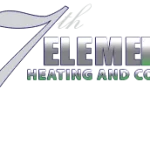Creating a healthier, safer, and more comfortable indoor environment for your family starts with the air you breathe.
For many families in Caldwell, Idaho, home is a sanctuary—a place of comfort, safety, and health. You’ve curated everything to create the perfect environment for your loved ones, from the decor to the structure itself. But what about the one element you interact with every second of the day? The quality of the air inside your home has a profound impact on your family’s well-being, influencing everything from allergy symptoms to sleep quality. Modern homes are built to be incredibly energy-efficient, but this tight seal can inadvertently trap airborne contaminants, leading to indoor air quality that can be significantly worse than the air outside.
An indoor air purification system is a powerful solution designed to address this very issue. It works silently within your existing HVAC system to remove pollutants, neutralize germs, and deliver cleaner, healthier air to every room. This guide explores how these systems work and why they are becoming an essential component for health-conscious homeowners in the Treasure Valley.
What’s Lurking in Your Home’s Air?
You may not see them, but your home’s air is filled with microscopic particles that can affect your health and comfort. These pollutants come from a wide range of sources, both inside and outside your home. Understanding what they are is the first step toward eliminating them.
Common Indoor Contaminants:
- Particulates: This broad category includes dust, pet dander, pollen, and smoke particles. Residents in Caldwell may also experience airborne dust from nearby agricultural activities.
- Volatile Organic Compounds (VOCs): These are gases emitted from common household products like cleaning supplies, paints, adhesives, new furniture, and air fresheners. They can cause headaches, dizziness, and long-term health effects.
- Biological Contaminants: Mold spores, bacteria, and viruses thrive in indoor environments. An overly dry or humid home can exacerbate these issues, which is why managing humidity with a whole-house humidifier can also play a role in air quality.
- Allergens: Seasonal pollen from local trees and grasses can easily make its way inside, triggering allergy and asthma symptoms for sensitive family members.
- Smoke: Smoke from regional wildfires is an increasing concern in Idaho, and these fine particles can penetrate homes, causing respiratory irritation.
How Whole-Home Air Purifiers Work
Unlike small, portable units that only clean the air in a single room, a whole-home air purifier integrates directly with your central heating and cooling system. As air circulates through your ducts, it passes through the purification unit before being distributed throughout your house. This ensures every room receives clean, filtered air. There are several effective technologies available:
Media Air Cleaners (HEPA-Style Filters)
These systems use a dense, high-efficiency filter to trap airborne particles. The MERV (Minimum Efficiency Reporting Value) rating indicates the filter’s effectiveness—the higher the MERV rating, the smaller the particles it can capture.
UV Air Sanitizers
Using powerful UV-C light, these purifiers neutralize biological contaminants like bacteria, viruses, and mold spores. As air passes by the UV lamp (typically installed in the ductwork), the light scrambles the organisms’ DNA, rendering them harmless.
Electronic Air Cleaners (Ionizers)
These devices use an electrical charge to make airborne particles “stick” together, causing them to fall out of the air or be trapped on a collector plate. They are effective at removing very fine particles like smoke and dust.
Air Purification Technologies at a Glance
| Technology | Best For Removing | Key Benefit |
|---|---|---|
| Media Air Cleaners (High-MERV) | Dust, Pollen, Pet Dander, Smoke | Excellent for allergy sufferers; traps physical particles. |
| UV Air Sanitizers | Viruses, Bacteria, Mold Spores | Neutralizes germs and prevents microbial growth in your HVAC system. |
| Electronic Air Cleaners | Fine Particles, Smoke, Fumes, VOCs | Washable collector cells mean no filters to replace. |
Many modern solutions combine two or more of these technologies for comprehensive, multi-stage air purification.
Did You Know?
According to the EPA, the concentration of some pollutants is often 2 to 5 times higher indoors than outdoors. Since most people spend about 90% of their time indoors, improving your home’s air quality is one of the most impactful steps you can take for your family’s health.
Choosing the Right System for Your Caldwell Home
Selecting the ideal indoor air purification system depends on your family’s specific needs and your home’s characteristics. Here are a few key considerations:
1. Identify Your Primary Concerns
Does someone in your home suffer from bad seasonal allergies? Are you concerned about lingering cooking odors or the dander from a beloved pet? If allergies are the main issue, a high-MERV media filter is essential. If you want to combat germs, a UV sanitizer is a great choice. Understanding your goals will help narrow down the options.
2. Consider Your Existing HVAC System
A whole-home air purifier must be compatible with your current furnace and air conditioner. An expert technician can assess your system to determine the best fit and ensure proper installation for optimal performance. Professional HVAC installation and repair expertise is crucial for seamless integration.
3. Plan for Maintenance
All air purifiers require some upkeep. Media filters need to be replaced periodically, while electronic collectors need regular cleaning. Enrolling in an HVAC maintenance plan can simplify this process, ensuring your purifier and entire HVAC system are always working efficiently.
Your Local Air Quality Partner in Caldwell
At 7th Element Heating and Cooling, we understand the unique environmental factors that affect homes in Caldwell and across the Treasure Valley. We are committed to providing health-forward solutions that create a truly comfortable and clean indoor space for your family. Our team doesn’t rely on high-pressure sales tactics; instead, we focus on educating you about your options so you can make an informed decision that provides long-term value. From advanced air purification systems to high-efficiency heat pumps, we offer a full suite of services to enhance your home’s health and comfort.
Ready to Breathe Cleaner, Healthier Air?
Let the experts at 7th Element Heating and Cooling help you find the perfect indoor air purification system for your home. Schedule a consultation today to learn more about our solutions.
Frequently Asked Questions
Q: How often do I need to maintain an air purification system?
A: Maintenance frequency depends on the type of system. Media filters generally require replacement every 6-12 months. UV bulbs last for about 1-2 years. Electronic collectors should be cleaned every 3-4 months. We cover all necessary maintenance in our service plans.
Q: Will an air purifier really help with my allergies?
A: Yes, absolutely. A high-quality whole-home air purifier is one of the most effective ways to reduce indoor allergens like pollen, pet dander, and dust mites. By capturing these particles before they circulate, the system can significantly reduce allergy and asthma symptoms.
Q: Can an air purification system remove smoke odors?
A: Yes. Systems with activated carbon filters or certain types of electronic air cleaners are highly effective at adsorbing the particles and gases that cause smoke odors, whether from wildfires or cooking.
Q: Is a whole-home system better than a portable unit?
A: While portable units can be effective for a single room, a whole-home system is far more powerful and convenient. It cleans the air in every room of your house, operates silently within your ductwork, and requires less frequent maintenance than multiple portable units.
Glossary of Terms
- HEPA: High-Efficiency Particulate Air. A standard for filters that are certified to trap 99.97% of particles that are 0.3 microns in size.
- MERV: Minimum Efficiency Reporting Value. A scale from 1-16 that rates the effectiveness of air filters. A higher number indicates finer filtration.
- UV-C Light: A specific spectrum of ultraviolet light that is germicidal, meaning it deactivates the DNA of bacteria, viruses, and other pathogens.
- VOCs (Volatile Organic Compounds): Chemicals that are emitted as gases from certain solids or liquids. They are common in many household products and can have short- and long-term adverse health effects.

